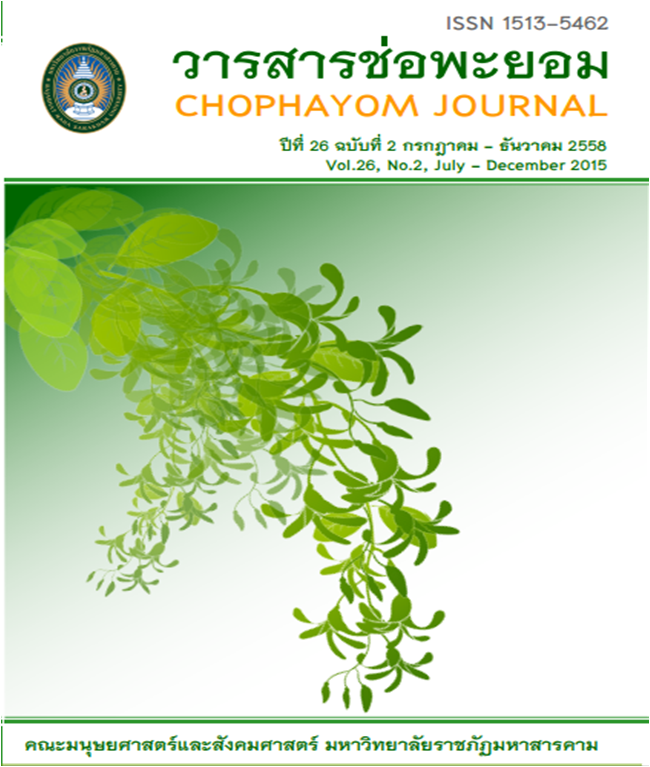การพัฒนารูปแบบหมู่บ้านจัดการสุขภาพโดยการมีส่วนร่วมของชุมชนจังหวัดมหาสารคาม The Model Developmentof Health Management Village for Community Participation in MahaSarakham Province
Abstract
บทคัดย่อ
การศึกษาครั้งนี้มีวัตถุประสงค์ เพื่อ1) ศึกษาสถานการณ์การพัฒนาหมู่บ้านจัดการสุขภาพ 2) พัฒนากระบวนการการพัฒนาหมู่บ้านจัดการสุขภาพโดยการมีส่วนร่วมของชุมชน 3)ศึกษาผลการพัฒนาหมู่บ้านจัดการสุขภาพ เป็นการวิจัยเชิงปฏิบัติการมี4 ขั้นตอน พื้นที่ดำเนินงาน คือ บ้านขอนแก่น หมู่ที่ 3 ตำบลวังแสง อำเภอแกดำ จังหวัดมหาสารคาม ผู้ร่วมวิจัยคือ กลุ่มแกนนำ/ตัวแทนชุมชน และกลุ่มผู้นำระดับครอบครัว เก็บข้อมูลโดยใช้แบบสัมภาษณ์วิเคราะห์ข้อมูลโดยการสถิติแบบพรรณนาสถิติอนุมานและการวิเคราะห์เชิงเนื้อหาระยะเวลาดำเนินงานเดือนกรกฎาคม- ธันวาคม 2554
ผลการวิจัยพบว่า 1) ก่อนการพัฒนาพบว่าหมู่บ้านมีผลการประเมินหมู่บ้านจัดการสุขภาพ ผ่านเกณฑ์โดยรวม 5 ด้าน ร้อยละ 88.83ระดับศักยภาพของการพัฒนาหมู่บ้านจัดการสุขภาพผ่านเกณฑ์โดยรวม 5 ด้านร้อยละ 76.85โดยผ่านเกณฑ์การประเมินในระดับดี (ระดับ 4 ดาว) แต่พบว่าผลการประเมินรายด้านไม่ผ่านเกณฑ์ 3 ด้าน คือด้านการจัดการทุนเพื่อสุขภาพ ด้านการจัดการข้อมูลเพื่อใช้ในกระบวนการวางแผนสุขภาพชุมชนและด้านการถ่ายทอดความรู้สุขภาพสู่ชุมชนผลการประเมินกลุ่มผู้นำระดับครอบครัว และกลุ่มแกนนำ/ตัวแทนชุมชน พบว่าการมีส่วนร่วมการพัฒนา และการได้รับผลประโยชน์ อยู่ในระดับต่ำ มีการรับรู้ ความภาคภูมิใจ และทัศนคติต่อการพัฒนาหมู่บ้านจัดการสุขภาพ อยู่ในระดับปานกลาง แกนนำและตัวแทนของชุมชนมีความรู้และศักยภาพในการจัดการสุขภาพชุมชนโดยรวมทุกด้านอยู่ในระดับปานกลาง ผู้นำระดับครอบครัวมีความรู้อยู่ในระดับดี 2) ขั้นตอนการวางแผนแก้ไขปัญหาและพัฒนาหมู่บ้านจัดการสุขภาพ และการดำเนินงานตามแผน พบว่ากลยุทธ์ที่ใช้ในการวางแผน คือ (1)การติดต่อสื่อสารแบบสองทางและไม่เป็นทางการ (2) หลักการบริหารจัดการแบบมีส่วนร่วมของชุมชน (3)การศึกษาดูงานและแลกเปลี่ยนเรียนรู้กับชุมชนที่ประสบความสำเร็จในการพัฒนา (4)ใช้ข้อมูลจริงจากพื้นที่ในการวิเคราะห์สถานการณ์ และวางแผนพัฒนา (5) การยกย่องชมเชย และสร้างขวัญกำลังใจให้แก่ชุมชนกระบวนการวางแผน เริ่มจากการประชุมและนำเสนอผลการวิเคราะห์ปัญหาของชุมชน เพื่อกำหนดแผนพัฒนาหมู่บ้านจัดการสุขภาพ 5 ด้าน และได้แผนงานทั้งหมด 6 แผนงาน 20 กิจกรรมดำเนินงาน 3) ขั้นตอนการประเมินผลการดำเนินงานหลังการพัฒนาหมู่บ้านพบว่าหมู่บ้านมีคะแนนการประเมินผลการพัฒนาหมู่บ้านจัดการสุขภาพ 5 ด้านผ่านเกณฑ์ ร้อยละ 100 เพิ่มขึ้นร้อยละ 12.57 ซึ่งผ่านเกณฑ์การประเมินโดยรวมทั้ง 5 ด้านโดยมีระดับศักยภาพการพัฒนาหมู่บ้านจัดการสุขภาพของหมู่บ้านโดยรวม 5 ด้านร้อยละ 95.37 เพิ่มขึ้นร้อยละ 24.10 ผ่านเกณฑ์ประเมินโดยรวมและรายด้านอยู่ในระดับดีมาก (ระดับ 5 ดาว) กลุ่มผู้นำระดับครอบครัว ก่อนและหลังพัฒนา
พบว่า ทั้ง 6 ด้านเพิ่มขึ้น มีค่า p -value < 0.001 กลุ่มแกนนำและตัวแทนชุมชนก่อนและหลังพัฒนา พบว่า ทั้ง 6 ด้านเพิ่มขึ้น มีค่าp -value < 0.001ด้านศักยภาพของแกนนำและตัวแทนชุมชนในการจัดการสุขภาพชุมชน ภาพรวมทุกด้านและรายด้านก่อนและหลังการพัฒนา พบว่า ในภาพรวมทุกด้านมีค่าเฉลี่ยเพิ่มขึ้น p-value < 0.001 ผลการประเมินความความพึงพอใจของผู้นำระดับครอบครัวต่อการดำเนินกิจกรรมการพัฒนาสุขภาพของชุมชน พบว่าในภาพรวมมีความพึงพอใจ อยู่ในระดับสูง ปัจจัยแห่งความสำเร็จในการพัฒนาหมู่บ้านจัดการสุขภาพครั้งนี้ คือ 1) มีการบริหารจัดการดี และมีภาวะผู้นำที่เข้มแข็ง 2) มีการสร้างเครือข่ายและการประสานงานที่ดีทั้งภายในและภายนอกชุมชน 3) กระแสปัญหาที่มีในชุมชน4) ชุมชนมีความสัมพันธ์ที่ดีเป็นความสัมพันธ์เชิงระบบเครือญาติ5) มีการศึกษาและแลกเปลี่ยนเรียนรู้จาก/กับชุมชนต้นแบบ
คำสำคัญ :การพัฒนารูปแบบ, หมู่บ้านจัดการสุขภาพ, การมีส่วนร่วมของชุมชน
ABSTRACT
The objective of the research were to 1) identify the problems and development situation of health management village 2) to develop a model with community participation on health management village 3) to evaluated the implementation of the developed model. It is an action research. The research consisted of 4 steps. This research was conducted in Ban KhonKaen, Moo 3, Wansaeng Sub-district, Kaedum District, MahaSarakham Province between July and December 2011. Tools were structure questionnaire and meeting agendas developed for questionnaire interview and meetings of the community and family leaders to identify the problems, planning, facilitation the implementation and evaluation. The data was analyzed using descriptive and inferential statistics for quantitative data and content analysis for qualitative data.
The results indicated that1) Problem identification step through the participatory meeting of community leaders, it was found that before the model development the successfulness of being the health management village score for 5 dimensions was 88.83%with the overall competency of 76.85% which was considered as a good level (4 stars). In term of domain, some communities did not pass the 3 domains: health fund management domain, management of data for community health planning and disseminate health information to the community. They had low level of participation and gaining benefit. Community and family leaders had medium level of awareness, participation, proud, knowledge and attitude towards health management village.They had medium level of knowledge and competency in overall community health management. Family leaders had good knowledge on health management.2) For planning to solve the problems and community health development based on identified problems through participation of all sectors and implementation, it was found that the strategies which were used in planning were (1) two-ways and informal communication (2) community participation in management (3) field visit and experiences sharing with successful village (4) using evident based information for situational analysis and planning (5) appreciation, praiseand motivation for the community. They could develop 6 plans with20 activities.3) The evaluation was found that after the implementation, the village had health management village score of 100%with a 12.57 percent increased, they could pass all 5 dimensions and had overall health management village competency of 95.37%with a 24.10 % increased, and was categorized into the very good level (5 stars). Concerning the community and family leaders, the comparison between pre- development and post- development indicated that. Six domains hadp -value < 0.001. Comparing pre- development and post- development concerning the community leader and representative indicated that. Six domains had p -value < 0.001. Concerning competency of community leader and representative on community health management, comparing before and after the development indicated that the overall score with the mean different of 24.06scores p-value < 0.001.The family leaders had high level of satisfaction on ht community health development activities. The successful factors of this action research are 1) leaders had good management skills and leadership 2) able to develop network within and outside the community 3) awareness of community’s problems 4) good relationships from kinships resulted in esprit de corps 5) sharing experiences and learning from model community.
Keyword: Model Development, Health Management Village, Community Participation



